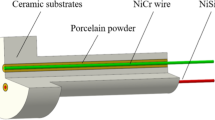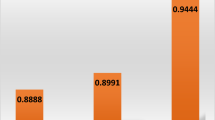Abstract
Activated tungsten inert gas (A-TIG) welding is an advanced version of TIG welding that uses activated flux to improve the penetration of weld joints. A-TIG is finding an increasing interest in the welding application due to the development of new fluxes. In recent years, machine learning has emerged as the most efficient computational tool for many manufacturing industries. In this study, a thermal camera equipped with an A-TIG welding setup was used to record the surface temperature of the weld region of the bead deposited on 304L steel. Five supervised machine learning algorithms were used to develop predictive models for the prediction of the surface temperature of the weld region in A-TIG welding for different activated fluxes. Decision tree, random forest (RF) and XGBoost are three machine learning models that were successfully implemented to predict the surface temperature with an acceptable error. Root mean square and mean square error using the RF achieved the least value equal to 16.45 and 19.922, respectively.










Similar content being viewed by others
References
Mustafa U, Chandra M, and Paulraj S, Trans. Indian Inst. Met. 71 (2018) 1975. https://doi.org/10.1007/s12666-018-1331-y
Vidyarthy R S, and Dwivedi D K, J. Manuf. Process. 22 (2016) 211. https://doi.org/10.1016/j.jmapro.2016.03.012
Pandya D, Badgujar A, and Ghetiya N, Mater. Manuf. Process. 36 (2021) 877. https://doi.org/10.1080/10426914.2020.1854467
Arinez J F, Chang Q, Gao R X, Xu C, and Zhang J, J. Manuf. Sci. Eng. 142 (2020) 110804
Verma S, Misra J P, and Popli D, Int. J. Model. Simul. 42 (2022) 1. https://doi.org/10.1080/02286203.2020.1803605
Mishra A, Int. J. Interact. Des. Manuf. (2023). https://doi.org/10.1007/s12008-022-01180-w
Choudhury B, Chandrasekaran M, and Devarasiddappa D, J. Brazilian Soc. Mech. Sci. Eng. 42 (2020) 1. https://doi.org/10.1007/s40430-020-02390-7
Pavan Kumar N, Devarajan P K, ArungalaiVendan S, and Shanmugam N, Int. J. Adv. Manuf. Technol. 93 (2017) 385. https://doi.org/10.1007/s00170-016-9562-8
Nalajam P K, and Varadarajan R, Exp. Tech. 45 (2021) 705. https://doi.org/10.1007/s40799-021-00451-7
Kumar A, Sarma R, Bag S, Srivastava V C, and Kapil S, Sci. Technol. Weld. Join. (2023). https://doi.org/10.1080/13621718.2023.2247242
Vidyarthy R S, Dwivedi D K, and Muthukumaran V, Mater. Manuf. Process. 33 (2018) 709. https://doi.org/10.1080/10426914.2017.1303154
Sivakumar J, and Naik K N, Mater. Today Proc. 27 (2020) 2718.
Vasudevan M, Bhaduri A K, Raj B, and Rao K P, Mater. Manuf. Process. 22 (2007) 641. https://doi.org/10.1080/10426910701323342
Sivakumar J, Vasudevan M, and Korra N N, Trans. Indian Inst. Met. 73 (2020) 555. https://doi.org/10.1007/s12666-020-01876-1
Alexopoulos K, Nikolakis N, and Chryssolouris G, Int. J. Comput. Integr. Manuf. 33 (2020) 429. https://doi.org/10.1080/0951192X.2020.1747642
Rokach L, and Maimon O, Lect. Notes Math. 1928 (2008) 67. https://doi.org/10.1007/978-3-540-75859-4_5
Li Z, Zhang Z, Shi J, and Wu D, Robot. Comput. Integr. Manuf. 57 (2019) 488. https://doi.org/10.1016/j.rcim.2019.01.004
Z. Zhang, Y. Huang, R. Qin, W. Ren, and G. Wen 2021 J. Manuf. Process. 64 (2021) 30. doi: https://doi.org/10.1016/j.jmapro.2020.12.004
Author information
Authors and Affiliations
Corresponding author
Ethics declarations
Conflict of interest
The author declares that there exists no competing financial interest or personal relationships that could have appeared to influence the work reported in this paper.
Additional information
Publisher's Note
Springer Nature remains neutral with regard to jurisdictional claims in published maps and institutional affiliations.
Supplementary Information
Below is the link to the electronic supplementary material.
Rights and permissions
Springer Nature or its licensor (e.g. a society or other partner) holds exclusive rights to this article under a publishing agreement with the author(s) or other rightsholder(s); author self-archiving of the accepted manuscript version of this article is solely governed by the terms of such publishing agreement and applicable law.
About this article
Cite this article
Chandra, M., Kumar, S., Ankit, K. et al. A Machine Learning Approach for Prediction of Surface Temperature of the Weld Region in A-TIG Welding. Trans Indian Inst Met 77, 907–917 (2024). https://doi.org/10.1007/s12666-023-03187-7
Received:
Accepted:
Published:
Issue Date:
DOI: https://doi.org/10.1007/s12666-023-03187-7




